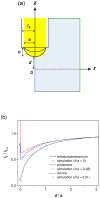Ion-selective permeability of an ultrathin nanoporous silicon membrane as probed by scanning electrochemical microscopy using micropipet-supported ITIES tips
- PMID: 20690617
- PMCID: PMC2932823
- DOI: 10.1021/ac1005052
Ion-selective permeability of an ultrathin nanoporous silicon membrane as probed by scanning electrochemical microscopy using micropipet-supported ITIES tips
Abstract
We report on the application of scanning electrochemical microscopy (SECM) to the measurement of the ion-selective permeability of porous nanocrystalline silicon membrane as a new type of nanoporous material with potential applications in analytical, biomedical, and biotechnology device development. The reliable measurement of high permeability in the molecularly thin nanoporous membrane to various ions is important for greater understanding of its structure-permeability relationship and also for its successful applications. In this work, this challenging measurement is enabled by introducing two novel features into amperometric SECM tips based on the micropipet-supported interface between two immiscible electrolyte solutions (ITIES) to reveal the important ion-transport properties of the ultrathin nanopore membrane. The tip of a conventional heat-pulled micropipet is milled using the focused ion beam (FIB) technique to be smoother, better aligned, and subsequently, approach closer to the membrane surface, which allows for more precise and accurate permeability measurement. The high membrane permeability to small monovalent ions is determined using FIB-milled micropipet tips to establish a theoretical formula for the membrane permeability that is controlled by free ion diffusion across water-filled nanopores. Moreover, the ITIES tips are rendered selective for larger polyions with biomedical importance, i.e., polyanionic pentasaccharide Arixtra and polycationic peptide protamine, to yield the membrane permeability that is lower than the corresponding diffusion-limited permeability. The hindered transport of the respective polyions is unequivocally ascribed to electrostatic and steric repulsions from the wall of the nanopores, i.e., the charge and size effects.
Figures







Similar articles
-
Nanoelectrochemistry at liquid/liquid interfaces for analytical, biological, and material applications.Chem Commun (Camb). 2023 Aug 3;59(63):9575-9590. doi: 10.1039/d3cc01982a. Chem Commun (Camb). 2023. PMID: 37458703 Free PMC article. Review.
-
Quantitative imaging of ion transport through single nanopores by high-resolution scanning electrochemical microscopy.J Am Chem Soc. 2012 Jun 20;134(24):9856-9. doi: 10.1021/ja3023785. Epub 2012 Jun 6. J Am Chem Soc. 2012. PMID: 22655578 Free PMC article.
-
Characterization of Nanopipet-Supported ITIES Tips for Scanning Electrochemical Microscopy of Single Solid-State Nanopores.Anal Chem. 2017 Sep 19;89(18):9946-9952. doi: 10.1021/acs.analchem.7b02269. Epub 2017 Sep 1. Anal Chem. 2017. PMID: 28819966 Free PMC article.
-
A structure-permeability relationship of ultrathin nanoporous silicon membrane: a comparison with the nuclear envelope.J Am Chem Soc. 2008 Apr 2;130(13):4230-1. doi: 10.1021/ja711258w. Epub 2008 Mar 7. J Am Chem Soc. 2008. PMID: 18324815 Free PMC article.
-
Asymmetric ion transport through ion-channel-mimetic solid-state nanopores.Acc Chem Res. 2013 Dec 17;46(12):2834-46. doi: 10.1021/ar400024p. Epub 2013 May 28. Acc Chem Res. 2013. PMID: 23713693 Review.
Cited by
-
Ultrathin Dual-Scale Nano- and Microporous Membranes for Vascular Transmigration Models.Small. 2019 Feb;15(6):e1804111. doi: 10.1002/smll.201804111. Epub 2019 Jan 11. Small. 2019. PMID: 30632319 Free PMC article.
-
Operando Scanning Electrochemical Probe Microscopy during Electrocatalysis.Chem Rev. 2023 Apr 26;123(8):4972-5019. doi: 10.1021/acs.chemrev.2c00766. Epub 2023 Mar 27. Chem Rev. 2023. PMID: 36972701 Free PMC article. Review.
-
Nanoelectrochemistry at liquid/liquid interfaces for analytical, biological, and material applications.Chem Commun (Camb). 2023 Aug 3;59(63):9575-9590. doi: 10.1039/d3cc01982a. Chem Commun (Camb). 2023. PMID: 37458703 Free PMC article. Review.
-
Ion permeability of the nuclear pore complex and ion-induced macromolecular permeation as studied by scanning electrochemical and fluorescence microscopy.Anal Chem. 2014 Feb 18;86(4):2090-8. doi: 10.1021/ac403607s. Epub 2014 Feb 6. Anal Chem. 2014. PMID: 24460147 Free PMC article.
-
Use of the MicroSiM (µSiM) Barrier Tissue Platform for Modeling the Blood-Brain Barrier.J Vis Exp. 2024 Jan 12;(203):10.3791/65258. doi: 10.3791/65258. J Vis Exp. 2024. PMID: 38284519 Free PMC article.
References
-
- Striemer CC, Gaborski TR, McGrath JL, Fauchet PM. Nature. 2007;445:749–753. - PubMed
-
- Vandezande P, Gevers LEM, Vankelecom IFJ. Chem Soc Rev. 2008;37:365–405. - PubMed
-
- Shannon MA, Bohn PW, Elimelech M, Georgiadis JG, Marinas BJ, Mayes AM. Nature. 2008;452:301–310. - PubMed
-
- Kooman JP, van der Sande FM, Leunissen KML. Blood Purification. 2007;25:377–382. - PubMed
-
- Adiga SP, Curtiss LA, Elam JW, Pellin MJ, Shih CC, Shih CM, Lin SJ, Su YY, Gittard SA, Zhang J, Narayan RJ. JOM. 2008;60:26–32.
Publication types
MeSH terms
Substances
Grants and funding
LinkOut - more resources
Full Text Sources
Other Literature Sources

